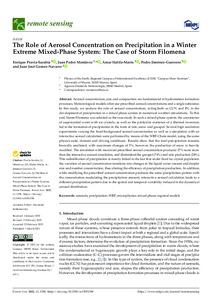Por favor, use este identificador para citar o enlazar este ítem:
http://hdl.handle.net/20.500.11765/14450
The Role of Aerosol Concentration on Precipitation in a Winter Extreme Mixed-Phase System: The Case of Storm Filomena
| Título : | The Role of Aerosol Concentration on Precipitation in a Winter Extreme Mixed-Phase System: The Case of Storm Filomena |
| Autor : | Pravia-Sarabia, Enrique; Montávez Gómez, Juan Pedro; Halifa Marín, Amar; Jiménez Guerrero, Pedro; Gómez Navarro, Juan José



|
| Palabras clave : | Aerosols; Precipitation; WRF; Mixed phase; Microphysics; Regional models |
| Fecha de publicación : | 2023 |
| Editor: | MDPI |
| Citación : | Remote Sensing. 2023, 15(5), 1398 |
| Versión del editor: | https://doi.org/10.3390/rs15051398 |
| Resumen : | Aerosol concentration, size and composition are fundamental in hydrometeor formation processes. Meteorological models often use prescribed aerosol concentrations and a single substance. In this study, we analyze the role of aerosol concentration, acting both as CCN and IN, in the development of precipitation in a mixed phase system in numerical weather simulations. To this end, Storm Filomena was selected as the case study. In such a mixed-phase system, the coexistence of supercooled water with ice crystals, as well as the particular existence of a thermal inversion, led to the formation of precipitation in the form of rain, snow and graupel. Several high resolution experiments varying the fixed background aerosol concentration as well as a simulation with an interactive aerosol calculation were performed by means of the WRF-Chem model, using the same physics suite, domain and driving conditions. Results show that the total precipitation remains basically unaltered, with maximum changes of 5%; however, the production of snow is heavily modified. The simulation with maximum prescribed aerosol concentration produced 27% more snow than the interactive aerosol simulation, and diminished the graupel (74%) and rain production (28%). This redistribution of precipitation is mainly linked to the fact that under fixed ice crystal population the variation of aerosol concentration translates into changes in the liquid water content and droplet size and number concentration, thus altering the efficiency of precipitation production. In addition, while modifying the prescribed aerosol concentration produces the same precipitation pattern with the concentration modulating the precipitation amount, interactive aerosol calculation leads to a different precipitation pattern due to the spatial and temporal variability induced in the dynamical aerosol distribution. |
| URI : | http://hdl.handle.net/20.500.11765/14450 |
| ISSN : | 2072-4292 |
| Colecciones: | Artículos científicos 2023-2026 |
Ficheros en este ítem:
| Fichero | Descripción | Tamaño | Formato | ||
|---|---|---|---|---|---|
| remotesensing-15-0139... | 22,18 MB | Adobe PDF |  Visualizar/Abrir |
Los ítems de Arcimis están protegidos por una Licencia Creative Commons, salvo que se indique lo contrario.





